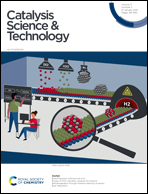Selectivity control of organic chemical synthesis over plasmonic metal-based photocatalysts
Abstract
Plasmonic metal-based photocatalysts have attracted increasing attention for highly selective organic chemical synthesis due to the easily tunable electronic and optical properties, and the superior photochemical durability. In this review, we first present the basic principles for localized surface plasmon resonance (LSPR) and mechanisms for the direct and indirect plasmonic metal-based photocatalysis. Then, the main strategies for improving the product selectivity of LSPR-mediated organic chemical synthesis are illustrated with typical examples, including control of light irradiation, tuning the composition of solvents, and engineering the configuration of plasmonic photocatalysts. For these strategies, a specific focus of photocatalyst engineering is put on modulating the LSPR properties by changing the nearby electric environment of plasmonic metallic nanostructures, which can renew the light absorption (determines the energy) and surface electronic configuration (determines the properties of surface active sites) of plasmonic metallic nanostructures to adjust the product selectivity. Additionally, the introduced supporting materials and ligands in plasmonic metal-based photocatalysts can also synergistically contribute to product selectivity. Finally, some issues that conceal the further comprehensive dissection of LSPR-mediated mechanisms and reaction pathways, and the mechanism-oriented design of plasmonic metal-based photocatalysts for selective photocatalytic organic chemical synthesis are presented.



 Please wait while we load your content...
Please wait while we load your content...